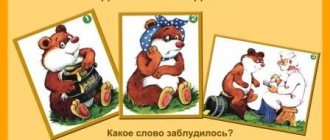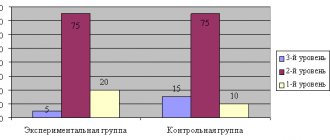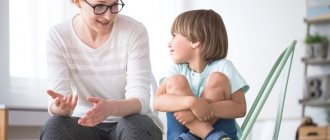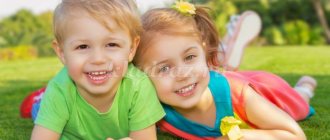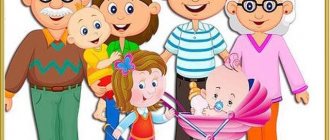Development of a child’s coherent speech - download tasks
The development of coherent speech is the main, advanced point in the development of communicative abilities and maturation.
Through the speech apparatus, the child learns to communicate. A vocabulary and the ability to convey feelings and thoughts become the key to comfortable learning and perception of the world. Poor development of coherent speech in preschoolers often causes hysterics and worries parents. The childdevelop website presents exercises for the development of coherent speech, developed by experienced teachers, psychologists and speech therapists. The author's methods and visual exercises for the development of coherent speech will be beneficial and useful.
Pictures for children on the theme “Winter and winter fun”
Story pictures are a universal material for speech therapy work in kindergarten. They help the teacher solve the following problems:
- learn to write a descriptive story;
- enrich vocabulary;
- develop thinking, attention, imagination.
Various pictures for children depicting winter and winter fun should definitely be among the speech therapist's teaching materials. You can use special themed sets for kindergarten or select suitable images yourself. Let's consider several options for pictures about winter that will help in your work.
The picture Winter has come opens a series of images of nature selected for the new season. It can be used in classes in senior and preparatory groups, conducting classes on the topic “Winter”, “How animals prepare for cold weather”, “Golden Autumn”, “Migratory birds”.
The plot picture Winter in the forest helps to clearly show children the changes that occur in nature, in the forest. A beautiful winter landscape helps expand a child's horizons and vocabulary.
The description of a winter forest can be played out as a journey, an imaginary adventure into a drawn area.
Snow-White Zimushchka-Winter is an ideal background for Russian folk tales; this can also be used in collective and individual work with children. A doll tetra on a transparent background superimposed on a forest landscape is suitable for this.
Stories about winter should also include a description of the New Year and Christmas holidays. Children love these Winter pictures more than others and are more willing to engage with them. It is very useful to select images of live Christmas trees in the forest and a decorated Christmas tree at a holiday, and then play “Find the Differences!”
The next picture is called Winter outside the window, it shows the life of the metropolis in the coldest time of the year. For the preparatory group, it is good to use images of snow-covered streets of a big city and winter in the countryside; a couple of these illustrations can be used for group work and games. Drawing winter in the city allows you to discuss with children not only changes in nature, but also conduct speech games and exercises on the topic of Transport and Professions, since at this time you can see new cars and people doing special work on the street.
Pictures depicting winter children's games and sports activities organized in the fresh air are an excellent opportunity not only to enrich children's active vocabulary and narrative speech, but also to work on reinforcing complex sounds. These could be exercises on differentiating between S and S, Z and Z, S and Z, S and Z.
Several pictures of winter fun will be useful for working in a group and for conducting open classes. A mnemonic table, which schematically shows:
- name of entertainment, game;
- its rules;
- its attributes;
- number of participants;
- best season.
For example, if the picture is dedicated to the winter fun “snowballs”, then the following should be noted in the table:
- the first sound of the game's name is soft S and the snowballs themselves;
- prohibition of throwing snowballs in the face, at animals and birds, at children;
- gloves, snow molds, shield, targets;
- one child and many;
- snowfall, large snowflakes.
With such support, children will be able to compose their own story not only following the example of an adult, but also with the help of independent analysis. No inscriptions are needed; even senior pupils can easily compose a complete story using clear, schematic pictures.
In speech therapy work, it is useful to use a series of story-based pictures on the topic of Winter fun, winter sports, etc. Here is an approximate list of games that a speech therapist can conduct on the topic of Winter fun using story-based pictures, one or a series:
- “What happened next?” (continue story)
- What's in the picture... (white, cold, fluffy, etc.)
- "Journey into Drawing"
- "Guess what I'm talking about!"
The themes of the arrival of winter and winter children's fun are a real “methodological treasure trove” for speech therapists and teachers. There are a huge number of options for using it. We have offered you just a few of them.
Literature:
Visual and didactic aid Stories from pictures Winter
Visual and didactic aid Stories from pictures Winter sports
N. Sozonova E. Kunitsina Notebook Stories about the seasons Winter
Development of coherent speech using effective practical tasks
The childdevelop portal presents materials to stimulate communication skills, active socialization and preparation for school. Tasks for the development of coherent speech in children are included in a separate category. The target audience of the portal is parents and relatives of the child, as well as people who use didactic materials in their professional activities (speech therapists, teachers, tutors, nannies). In turn, the available tasks for the formation of coherent speech are intended to be studied by children of different ages.
Many users have already appreciated the advantages of our portal:
- the resource offers to download interesting tasks for the formation of coherent speech in preschoolers, print them out and start learning at a convenient time;
- Each exercise was compiled by professional speech therapists, psychologists, and teachers. The technique has been approved for use;
- various manuals are aimed at improving various communication abilities: increasing vocabulary, correctly constructing applications, teaching etiquette, developing coherent speech in older preschoolers;
- tasks are adapted to true life conditions and describe current situations and surrounding objects;
- on the site you will find everything necessary for the development of coherent speech in preschool children, as well as in older preschoolers;
- The educational process based on working materials takes place in a playful way. What develops logic, thoughts, improves memorization, communication skills and imagination.
Pictures for speech development
Picture 1 This is Tanya and Vanya. They are brother and sister. One day Tanya and Vanya woke up and looked out the window. Oh, what beauty! Someone drew patterns on the glass. And outside the window... a white fur coat covered the whole world. What is this? That's right, there is snow on the branches. So, she came... (Talk to the child about the snow, frosty patterns on the glass, about bullfinches, about rowan trees, about trees that have shed their leaves.)
Picture 2
Tanya and Vanya love to play outside in winter. Do you love? Hurry up to the street! Tanya and Vanya are great, they dress themselves. Vanya put on overalls, but what is Tanya wearing? (Fur coat.) Do you like Tanya’s hat? Who has a better hat, Tanya or Vanya? What kind of hat do you have? What do you wear when you go out? (Talk with your child about winter clothes, their types, colors, etc.)
Picture 3
Who is this rushing on a sled down a snowy hill? (Tanya.) Do you think Tanya likes sledding? Where is Vanya? See how well he skis. I just lost my sticks somewhere. But look how he waves his hands! A real skier! What do you like to do more: skiing or sledding? (Talk to your child about the boy on the snow scooter, about your downhill ride, etc.)
Picture 4 Oh, there's so much snow outside! What big snowflakes are flying! Here is Vanya. He rolls a big ball. What did Tanya blind? Look what the snowman has instead of a nose? What kind of snowman do you think Vanya will build? (Wait for the child’s full answer.) What do you like to sculpt from snow? (Draw snowflakes, a snowman, and footprints in the snow on a white or blue sheet of paper.)
Picture 5 It's cold in winter. It is difficult for birds and animals to find food. But they do not lose heart - how joyfully they fly and jump from branch to branch. Yes, and we will help them - we will treat them with something, right? You see, Tanya brought seeds for the birds, and Vanya brought a nut for the squirrel. Well done Tanya and Vanya! (Continue the conversation: what birds does the child know, what berries hang at the feeder, etc.)
Picture 6
In winter there is a very cheerful holiday. Do you know which one? That's right, New Year. For the New Year, they decorate the Christmas tree with shiny toys and light colorful lights on it. Do you like decorating the Christmas tree? Look what a beautiful Christmas tree. Who's near the Christmas tree? (Wait for the child’s detailed answer.) See how smart the children are! And they dance so fervently! Let's find Tanya and Vanya among them. (Look at the toys on the Christmas tree, find out who the kids dressed up as, remember or dream about your holiday.) Thank you, winter, winter, for the holiday!
Picture 7 Who came to the guys for the holiday? (Talk about where Santa Claus lives, what kind of beard and clothes he has, how kind he is, how he loves children.) What does he have in his bag? Do you like Snow Maiden? What is she wearing? What gifts did Father Frost and Snow Maiden bring to Tanya and Vanya? What gift did you get for New Year?
How to read stories with pictures correctly
An adult and a child take part in the reading. The adult reads the lettered part of the story and pauses when an image appears in the text. The child names what he sees in the picture.
Having reached the end of the text, the adult asks the question: “What was the story about?”, “What were the names of ... (the characters).” Answering these questions, the little person does a lot of brain work. He uses his memory to try to remember the text. Carefulness and logic, looking at the pictures, recreates the order of actions in the story. In the future, this knowledge will be consolidated in the subconscious, and it will be easier for the child to write summaries at school. He will learn to isolate certain points and, based on them, reproduce the entire text in memory.
Texts with pictures instead of some words are different:
- black and white;
- colorful;
- with stickers.
Their use largely depends on the age and level of development of the baby. For example, to make the baby more interesting, you can offer him to color black and white pictures. This will allow the little man to better remember the fairy tale and then tell it in his own words.
By the way, you should not use such manuals in electronic form. Young children get tired quickly when working with static pictures on a computer monitor or tablet screen. This means that such exercises will be ineffective.
So, if it is not possible to purchase fairy tales and stories with pictures instead of certain words, then it is better to download and print them. During the lessons, these leaves can be collected into a book, and then together with the child, make a cover for which he will come up with and draw some kind of picture.
Rules for speech therapy classes at home
The success of home lessons depends not only on the availability of the necessary aids and a work plan agreed upon with the speech therapist. The organization of classes itself is very important. Here are a few simple rules that will help you achieve excellent results:
- All speech therapy exercises for children should be carried out regularly, but a little at a time. You shouldn’t try to do articulation gymnastics, play speech games, or fill out a workbook right away. It is better to devote a few minutes to each type of exercise, rather than having a whole “speech therapy day.”
- Do not force them to complete tasks under pressure; educational activities for children should resemble a game. Come up with a simple plot (for example, a journey into the universe of sounds), prepare small prizes (stickers, paper stars), and arrange physical exercises.
- Praise and support the little student if he makes even the slightest progress. Focus on achievements, even small ones, gradually progress will become more and more obvious.
- Find good workbooks for home practice. They should not only be professional in content, but also bright, colorful, and exciting. It is ideal if the tasks have interactive elements (the opportunity to add something, draw something). Such material makes it possible to interest a preschooler and clearly shows him the “path traveled” and success.
- Don't expect instant results, be patient and gentle perseverance. The process of setting, consolidating, and differentiating sounds is complex; it takes months even for experienced speech therapists. Follow the plan and the results will gradually appear.
